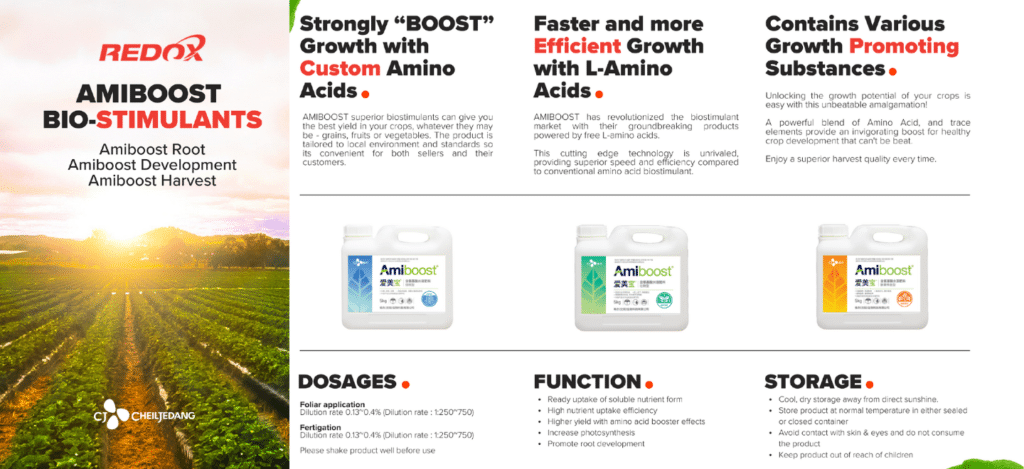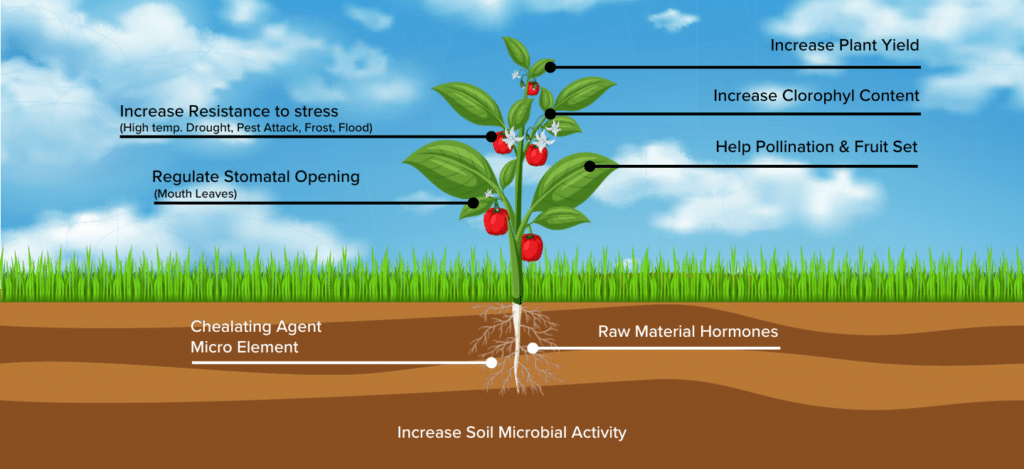In the world of agriculture, the battle for survival against nature’s forces is relentless. Factors such as light deficiency, water scarcity, pests, diseases, salinity, wind, and phytotoxicity continually challenge the resilience of plants. To aid in this ongoing struggle, Redox, in collaboration with CJ Bio, introduces AMIBOOST® —a high-quality biostimulant enriched with specialized amino acids. This remarkable product is meticulously designed to bolster crop yield and quality, addressing the needs of various plant types and growth stages. These amino acids act as catalysts for the plant’s secondary metabolism, a vital part of its immune system, enabling plants to thrive even in the face of adversity.
But surviving under stress is not the epitome of plant health. Instead, the plant has to divert its resources from primary metabolism, which deals with growth and development, to cope with these challenges. This is where amino acids come into play as an essential tool to bolster the plant’s defences and recovery mechanisms. They act as biostimulants that can make all the difference in a stressful situation.
Recognising that it wouldn’t be a single front of management that would solve this battle. To effectively combat stress, amino acids should be part of a broader strategy. This strategy should include factors like soil fertility management, pest and disease control, and proper irrigation, all of which contribute to a plant’s overall health and reduce stress. And an inclusion of Amino acids serves as a boost in these challenging situations.
However, not all amino acids are created equal in this plant kingdom, and the “L-amino acids” are the superheroes. Each amino acid has a unique role in this intricate world of plant survival, combating biotic and abiotic stressors.

Introducing the future of agricultural excellence: The latest innovation, Amiboost ROOT, Amiboost DEVELOPMENT, and Amiboost HARVEST. AMIBOOST’s superior biostimulants redefine crop yields, whether you’re cultivating grains, fruits, or vegetables. Crafted to harmonize with your local environment and quality standards, this revolutionary product ensures convenience for sellers and satisfaction for their customers. Elevate your crop with Amiboost – the key to unlock exceptional performance.
Understanding Plant Stress
The term “plant stress” encompasses various factors that disrupt a plant’s normal functions. These can range from insufficient light, water scarcity, salinity, strong winds, phytotoxicity, and pest and disease attacks, hindering a plant’s total development.
Plants employ two metabolic strategies: primary and secondary metabolism. Primary metabolism is associated with growth, including plant development, root and leaf expansion, and photosynthesis activity. In contrast, secondary metabolism acts as a plant’s immune system, a survival mechanism for adverse conditions.
Enduring stress at the metabolic level isn’t healthy for plants. To thrive, they need to adjust their primary metabolism and activate secondary metabolism. This is where amino acids come into play as essential tools.
The Role of Amino Acids
Recognising that plant stress doesn’t arise from a single source is crucial. To effectively combat stress, amino acids should be part of a broader strategy. This strategy should include factors like soil fertility management, pest and disease control, and proper irrigation, all of which contribute to a plant’s overall health and reduce stress. Amino acids serve as a valuable bio-stimulant in these challenging situations.
Plants rely on proteins as they are the basic constituents of all living cells. First, it’s important to highlight that protein is formed by combining different amino acids; about 20 crucial amino acids can help plants grow accurately.
How does it happen? So, plants synthesise amino acids from the carbon and oxygen obtained from air and hydrogen from water in the soil, forming carbon hydrate through photosynthesis and combining it with the nitrogen the plants obtain from the soil. As a result, the synthesis of amino acids. L-Amino Acids are part of these proteins and have metabolic activity, including hormone and enzymatic functions, structure building, immune response, nutrient transport, etc.
However, an adverse situation can occur, and the plant cannot generate these important amino acids efficiently. Hence, feeding your plants L-amino acids makes them perform these functions efficiently and better, consequently minimising negative stress.
In this way, if the 20 amino acids can be directly supplied, it will help to overcome the limitations caused by plant stress.
The type of amino acid must be considered; products should contain L-amino acids, Laevorotatory amino acids, or L-amino acids, as those are the ones that plants can assimilate.
The Significance of Amino Acids in Plant Metabolism
Plants naturally synthesise about 20 amino acids that are indispensable for their metabolism. Think of these amino acids as the oil in a car engine. Just as a car needs the right type and quantity of oil to function correctly, plants require specific amino acids for their well-being. Without these amino acids, plants may require intervention to thrive.
Each phase of a plant’s development demands specific types and quantities of amino acids. Using amino acids at the right time physiologically activates a plant’s metabolism, promoting its growth.
By understanding the significance of different amino acids and how they function, we can better support plant growth, even in challenging conditions.
Understanding Biotic Stress
Biotic stress in plants results from pest and disease infestations within crops. What renders a plant susceptible to these attackers is its production of sugars and compounds that serve as a food source for them.
Amino acids like Tyrosine, phenylalanine, and tryptophan play a vital role in this scenario. They are directly linked to producing phenolic compounds in a plant’s secondary metabolism. These phenolic compounds act as natural defence mechanisms, functioning like antibodies that thwart disease development and make the plant’s sap less appealing to pests.
Plants Under Abiotic Stress
In the face of abiotic stress, compounds like Folcysteine come to the plant’s rescue. Folcysteine is a derivative of the amino acid cysteine, and its primary function is to counteract free radicals, reducing oxidation. This is especially crucial because Folcysteine serves as a sulphur source and contributes to the synthesis of glutathione, a vital molecule in a plant’s defence system.
Proline plays a pivotal role in mitigating the effects of stress, particularly when it comes to hydric (water) and saline stress. It’s an amino acid renowned for its association with drought resistance, functioning as an osmo-protective agent, similar to arginine. Proline stabilises the plasma membrane, preventing structural damage, such as weakening the cell wall, especially during conditions like excessive temperature increases or water scarcity.

Abiotic stress in plants refers to the negative impact of non-living factors or environmental conditions on plant growth, development, and overall health. Unlike biotic stress, which is caused by living organisms such as pests and pathogens, abiotic stress factors are non-living and typically relate to various environmental factors.
Glycine is a crucial player in chlorophyll composition, facilitating the process of photosynthesis. Additionally, it assumes a critical role in maintaining the plant’s internal osmotic balance. Glycine is often accumulated in plants facing various stressors like excess water, salinity, cold, heat, and freezing conditions, as it actively contributes to upholding the integrity of cell membranes, thereby sustaining photosynthetic efficiency.
Addressing Phytotoxicity in Plants
These damages impair the normal development of plants, as they are mostly related to the interruption of production or distribution of photoassimilates. Injuries prevent the leaf from carrying out photosynthesis and can be a factor in loss of productivity. Amino acids are essential allies to minimise these harmful effects and encourage plants to recover their photosynthetic capacity.
Being small molecules quickly absorbed, they begin to act on metabolism in a few hours, transporting toxic elements and promoting the restoration of regular cellular activity in plants.
Heavy metals from the soil or in formulations used in crop management, nutritional elements in excess or with a high salt content, are examples of agents that cause phytotoxicity.
Histidine is an effective amino acid in complexing heavy metals such as cobalt, nickel, zinc, and copper.
Again, glycine is an essential amino acid in the composition of chlorophyll, and the isoleucine and glutamic acid in the growth of meristems, which are new tissues.
Roles of some amino acids in Adverse Situation.
- Aspartic Acid: It is a nitrogen source essential for producing other amino acids.
- Glutamic Acid: This amino acid plays a crucial role in the growth of meristems, the plant’s new tissues. It also serves as a precursor for chlorophyll and other amino acids since it carries nitrogen sources.
- Alanine: Alanine actively participates in the formation and germination of pollen grains.
- Arginine: Arginine offers resistance to drought, acting as an osmoprotectant. It is also involved in photosynthesis, growth, and the transport of nutrients to reproductive complexes.
- Cysteine: Cysteine is a pivotal amino acid. In addition to being a source of sulphur, it plays a vital role in synthesising glutathione, a crucial molecule in a plant’s defence system. It also aids in stress tolerance.
- Phenylalanine: This amino acid is closely linked to the production of phenolic compounds in the secondary metabolism of plants. These compounds act as plant defence agents, functioning like antibodies to inhibit disease development and making the plant’s sap less attractive to pests. Phenylalanine is involved in synthesising lignin, tannins, flavonoids, and the formation of salicylic acid.
- Glycine (1st Mention): Glycine participates in the formation of glutathione, phytochelatins, and betaine glycine. Betaine glycine is a compound that accumulates in plants under water-stress conditions, aiding in maintaining photosynthetic efficiency.
- Glycine (2nd Mention): Glycine is also essential in the composition of chlorophyll. It plays a critical role in photosynthesis and in regulating the intracellular osmotic balance of the plant. This amino acid is mainly accumulated in plants under various stressful conditions, such as water scarcity, salinity, cold, heat, and freezing stress, as it helps preserve the integrity of cell membranes and maintain photosynthetic efficiency.
- Glutamate: Glutamate participates in the formation of amino acids like arginine, glutamine, and proline. It also acts as a precursor for the chlorophyll molecule.
- Histidine: Histidine is recognised as the most effective amino acid for complexing heavy metals such as cobalt, nickel, zinc, and copper.
- Isoleucine: Isoleucine plays a role in the growth of meristems, which are new plant tissues. It also contributes to forming other amino acids and pollen grain germination.
- Leucine: Leucine is another amino acid that forms other amino acids and plays a role in pollen grain germination.
- Lysine: Lysine is responsible for regulating pollen grain germination and stomatal regulation. It is also a vital nitrogen reserve in plants and activates chlorophyll.
- Methionine: Methionine is a precursor for ethylene, a hormone that influences fruit maturation. It is also responsible for sulphur incorporation in plants.
- Proline: Proline is an amino acid associated with drought resistance, similar to arginine. It functions as an osmoprotectant and is used by the plant as a defence mechanism against water deficits and heat stress.
- Serine: Serine constitutes enzymes that activate proteins facilitating plant growth and the transport of nutrients in the plant’s sap.
- Tyrosine: Tyrosine is linked to the production of phenolic compounds in the secondary metabolism of plants. These compounds function as plant defence agents, inhibiting disease development and making sap less attractive to pests.
- Threonine: Threonine participates in forming other amino acids and is involved in pollen grain germination.
- Tryptophan: Tryptophan is associated with the production of phenolic compounds in the secondary metabolism of plants. Like tyrosine, it is a defence agent against diseases and pests, making the plant’s sap less appealing. Tryptophan also serves as a precursor for auxin, a root growth hormone, and influences the development of aerial plant parts.
- Valine: Valine plays a role in regulating the growth and maturation of fruits.
These amino acids play a fundamental role in maintaining the health and vitality of the crop.
How can we help?
At Redox, we understand the critical role that amino acids play in plant metabolism and stress management. We are committed to providing top-quality amino acid products that can make a significant difference in the health and vitality of your plants. If you’re interested in learning more about our amino acid products or have any questions regarding their application and benefits, we encourage you to get in touch with us.
Our team of experts is here to assist you in implementing an effective strategy to enhance your plants’ overall health and reduce stress. Contact us today to explore how our amino acid solutions can contribute to your plant’s success. Your plants deserve the best, and we’re here to help you achieve just that.
